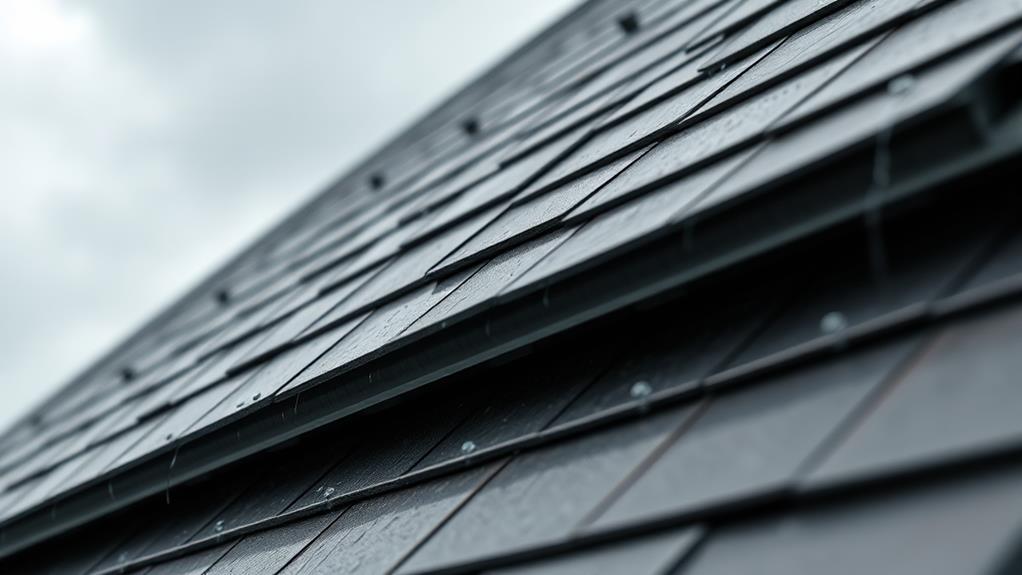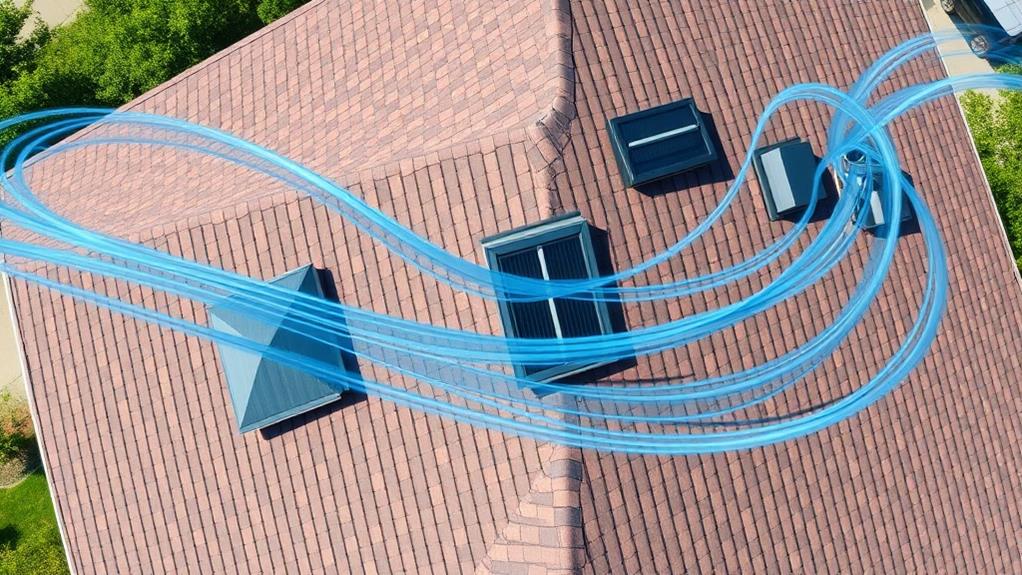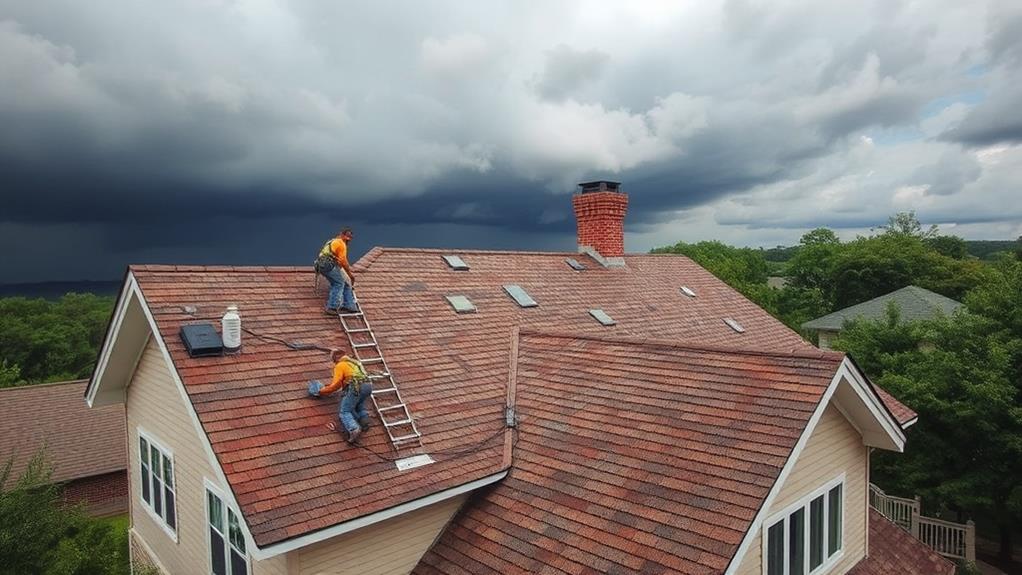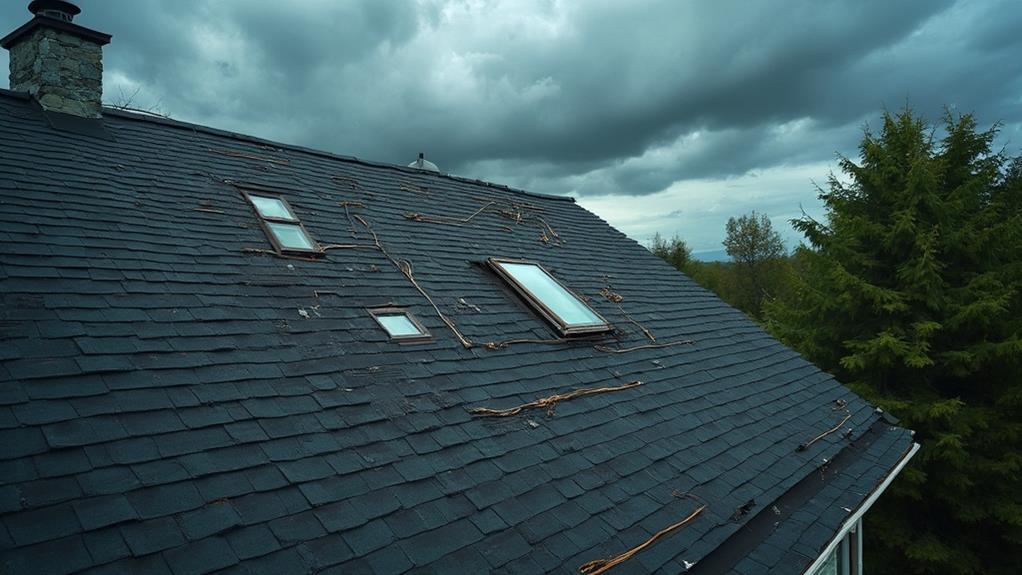Storm-proofing your roof involves several key upgrades to enhance its resilience against severe weather. Consider installing impact-resistant shingles, reinforcing the roof deck with high-quality underlayments, and improving ventilation systems. Upgrade to seamless gutters with guards and extend downspouts to ensure proper drainage. Implement strategic solutions like hurricane straps and Class 4 shingles for maximum protection. Regular professional inspections and maintenance are crucial for identifying potential issues and implementing proactive measures. These upgrades not only fortify your roof but also protect your entire home from weather-related damage. Exploring these options further can reveal additional benefits for long-term roof durability and peace of mind.
Reinforced Shingles and Roofing Materials

Durability is paramount when considering storm-proofing measures for your roof. Reinforced shingles and roofing materials offer superior protection against harsh weather conditions, including high winds, heavy rain, and hail. These enhanced products are engineered to withstand greater impacts and resist uplift forces that can compromise standard roofing materials.
Impact-resistant shingles, typically made from modified asphalt or reinforced with fiberglass, provide a robust defense against hail and flying debris. Class 4 impact-resistant shingles, the highest rating available, can withstand impacts from 2-inch steel balls dropped from 20 feet. For areas prone to high winds, wind-resistant shingles feature stronger adhesive strips and nailing zones, reducing the risk of blow-offs during storms.
Metal roofing systems offer another durable option, with some products rated to withstand winds up to 160 mph. Additionally, synthetic slate and shake materials combine the aesthetic appeal of traditional roofing with enhanced durability and weather resistance. When selecting reinforced roofing materials, consider products that meet or exceed local building codes and have been tested to industry standards such as UL 2218 for impact resistance and ASTM D3161 for wind resistance.
Enhanced Roof Deck Protection
Beyond reinforced shingles, enhanced roof deck protection forms a critical secondary defense against water infiltration and structural damage during severe weather events. This layer of protection is typically installed directly on the roof deck, beneath the underlayment and shingles.
High-quality synthetic underlayments offer superior water resistance compared to traditional felt paper. These materials are more durable, easier to install, and provide better coverage. Some advanced options include self-adhering ice and water shields, which create a watertight seal around vulnerable areas like eaves, valleys, and penetrations.
Proper ventilation is also crucial for enhanced roof deck protection. Adequate airflow helps regulate temperature and moisture levels in the attic, preventing issues like ice dams and extending the lifespan of roofing materials. Ridge vents, soffit vents, and gable vents work together to create a balanced ventilation system.
Additionally, reinforcing the roof deck itself can improve storm resistance. This may involve using thicker plywood sheathing, adding extra fasteners, or installing hurricane straps to secure the roof to the home's frame. These measures help prevent uplift and detachment during high winds.
Improved Ventilation Systems

A well-designed ventilation system is crucial for maintaining the integrity and longevity of your roof during severe weather events. Proper ventilation helps regulate temperature and moisture levels in the attic space, preventing issues like ice dams, condensation, and excessive heat buildup that can compromise the roof structure.
To improve your roof's ventilation system, consider installing ridge vents along the peak of the roof. These allow hot air to escape efficiently, creating a natural airflow that draws cooler air from soffit vents at the eaves. Ridge vents are less likely to be damaged by high winds compared to traditional roof vents.
Soffit vents should be kept clear of insulation and debris to ensure proper airflow. Installing baffles can help maintain an unobstructed path for air to circulate. Additionally, consider adding gable vents or solar-powered attic fans to enhance air circulation, especially in larger attic spaces.
For maximum efficiency, aim for a balanced system with equal intake and exhaust ventilation. This helps prevent pressure differentials that could allow wind-driven rain to enter the attic during storms. Consult a roofing professional to determine the optimal ventilation solution for your specific roof configuration and local climate conditions.
Strategic Gutter and Drainage Solutions
For effective storm-proofing, strategic gutter and drainage solutions play a crucial role in protecting your roof and home's foundation. Properly designed and installed gutter systems direct water away from your home, preventing water damage and erosion. Consider upgrading to seamless gutters, which reduce the risk of leaks and clogs. Install gutter guards to prevent debris accumulation and ensure smooth water flow during heavy rainfall.
Extend downspouts at least 5 feet away from your home's foundation to prevent water pooling near the structure. For areas with high water volume, install underground drainage systems to efficiently channel water away from your property. French drains or dry wells can be effective solutions for managing excess runoff.
Regularly inspect and clean your gutters, especially before and after major storms. Ensure proper slope for efficient water flow and check for any signs of damage or wear. In areas prone to ice dams, consider installing heated gutter cables to prevent ice buildup. Lastly, implement a comprehensive landscape drainage plan, including grading your yard away from the foundation and installing permeable surfaces to absorb excess water.
Professional Inspection and Maintenance Plans

Implementing a professional inspection and maintenance plan is crucial for ensuring long-term roof resilience against storms. Regular inspections by certified roofing professionals can identify potential vulnerabilities before they escalate into major issues. These experts can spot early signs of damage, wear, or weakness that may compromise your roof's integrity during severe weather events.
A comprehensive maintenance plan typically includes bi-annual inspections, ideally in spring and fall. During these assessments, professionals examine shingles, flashing, gutters, and underlying structures for signs of deterioration or storm damage. They also check for proper ventilation and insulation, which play vital roles in preventing ice dams and moisture buildup.
Professional maintenance often involves proactive measures such as replacing damaged shingles, reinforcing weak spots, and applying protective coatings. Additionally, experts can recommend and implement upgrades to enhance your roof's storm resistance, such as impact-resistant materials or improved fastening systems. By investing in professional inspection and maintenance, homeowners can significantly extend their roof's lifespan, improve its performance during storms, and potentially avoid costly emergency repairs or premature replacement.
Frequently Asked Questions
How Long Does a Storm-Proofed Roof Typically Last?
A storm-proofed roof's lifespan typically ranges from 20 to 50 years, depending on materials used and maintenance. High-quality metal roofs can last up to 70 years, while asphalt shingles may need replacement after 20-30 years of weathering extreme conditions.
Can Storm-Proofing Measures Be Added to an Existing Roof?
Yes, storm-proofing measures can be added to an existing roof. Common upgrades include installing impact-resistant shingles, reinforcing roof decking, applying sealants, and improving drainage systems. However, the effectiveness may vary depending on the roof's current condition and structure.
What's the Average Cost to Storm-Proof a Residential Roof?
Prepare for a jaw-dropping revelation! The average cost to storm-proof a residential roof varies wildly, typically ranging from $5,000 to $20,000. Factors influencing this include roof size, materials used, and specific upgrades implemented for protection.
Are There Insurance Discounts for Storm-Proofed Roofs?
Many insurance companies offer discounts for storm-proofed roofs, as they reduce the risk of damage claims. Homeowners can typically save 5-20% on premiums, depending on the specific upgrades and the insurer's policies. Contact your provider for details.
How Do Different Climates Affect Storm-Proofing Requirements?
Like a chameleon adapting to its environment, storm-proofing requirements vary by climate. Coastal regions need hurricane-resistant materials, while snowy areas require strong supports. Hot climates benefit from reflective coatings, and high-wind zones demand secure fastening systems.
Conclusion
In conclusion, storm-proofing a roof requires a multifaceted approach. Reinforced materials, enhanced deck protection, improved ventilation, and strategic drainage solutions form the backbone of a resilient roofing system. Regular professional inspections and maintenance plans are crucial for long-term durability. Implementing these upgrades can transform a vulnerable roof into an impenetrable fortress, capable of withstanding even the most apocalyptic storms. Homeowners who prioritize these enhancements will enjoy increased peace of mind and reduced repair costs during severe weather events.

